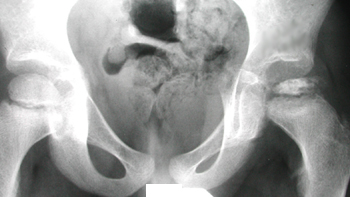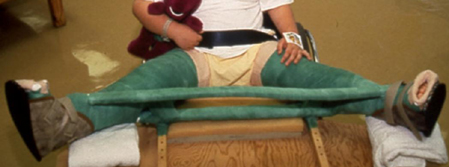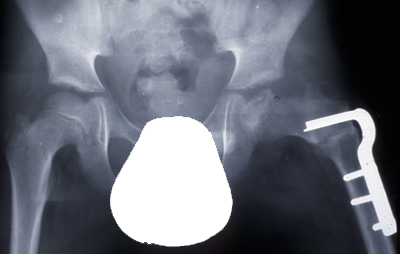Perthes Disease
Perthes is a condition in children characterized by a temporary loss of blood supply to the hip. Without an adequate blood supply, the rounded head of the femur (the " ball " of the " ball and socket " joint of the hip) dies. The area becomes intensely inflamed and irritated.
Although the term 'disease' is still used, Perthes is really a complex process of stages. Treatment of Perthes may require periods of immobilization or limitations on usual activities. The long-term prognosis is good in most cases. After 18 months to 2 years of treatment, most children return to normal activities without major limitations.
Perthes disease usually is seen in children between 4 years and 10 years of age. It is five times more common in boys than in girls. It was originally described nearly a century ago as a peculiar form of childhood arthritis of the hips.
Symptoms
The child may show signs of limping and may complain of mild pain. The child may have had these symptoms intermittently over a period of weeks or even months. Pain sometimes is caused by muscle spasms that may result from irritation around the hip. Pain may be felt in other parts of the leg, such as the groin, thigh, or knee. When the hip is moved, the pain worsens. Rest often relieves the pain.
Diagnosis
X-rays usually diagnose the condition. The child with Perthes can expect to have several X-rays taken over the course of treatment, which may be two years or longer. The X-rays usually will look worse before gradual improvement is seen.

Perthes disease involves the patient's left hip. The other side is normal.
(Courtesy of Texas Scottish Rite Hospital for Children)
Treatment
Girls tend to have more extensive involvement; therefore, the expectations (prognosis) are generally poorer than with boys.
For very young children (those 2 to 6 years of age) who show very few changes on their initial X-rays, treatment is usually simply observation.
The older child is treated in order to improve the hip's range of motion.
Nonsurgical Treatment
Anti-inflammatory medications, such as ibuprofen, are used to lessen inflammation of the hip joint or synovium (sleeve of tissue surrounding the hip joint). These medicines are often used for months. The medications will be adjusted or discontinued, depending on the healing stage.
A child with Perthes disease may tend to walk with a limp due to a stiff hip. To help restore hip joint range of motion, the child may be encouraged to walk with crutches and participate in physical therapy. Bed rest in traction may be needed in some cases, however.
With physical therapy, the child will be shown some simple exercises to do until the final stage of healing has occurred.
Hip abduction
The child will lie on his or her back, keeping knees bent and feet flat. With the parent's hands on the child's knees, assist the child as he or she pushes the knees out and as squeezes the knees together.
Hip rotation
With the child on his or her back and with the legs out straight, roll the entire leg inward and outward.
If range of motion becomes limited or if X-rays or MRIs indicate that a progressive deformity is developing, a cast may be used to keep the head of the femur within the acetabulum, or hip socket.
Petrie casts are two long leg casts with a wooden bar that hold the legs spread apart in a position similar to the letter "A." The application of the initial Petrie cast usually is performed in the operating room. During the procedure, the surgeon usually will place a small amount of dye into the hip joint (arthrogram) to aid in evaluating the degree of "flattening" of femoral head. Occasionally, the adductor longus muscle in the groin must be lengthened through a small incision to permit the hip to rotate into a more favorable position.

Petrie casts keep the legs spread far apart in an effort to maintain the hips in the best position for healing.
(Courtesy of Texas Scottish Rite Hospital for Children)
After the cast is removed, usually after four to six weeks, exercises are reinstituted. This treatment may be continued until range of motion is returned or the hip enters the final stage of the healing process.
Surgical Treatment

An osteotomy to the left hip puts the femoral head in a better position to heal.
(Courtesy of Texas Scottish Rite Hospital for Children)
Surgical treatment re-establishes the proper alignment of the bones of the hip. The head of the femur is placed deep within the socket, or acetabulum. This alignment is kept in place with screws and plates, which will be removed at a later time. In some cases, the socket must also be made deeper because the head of the femur has actually enlarged during the healing process and no longer fits snugly within. After either procedure, the child is often placed in a cast from the chest to the toes for 6 to 8 weeks.
After the cast is removed, the child will again participate in physical therapy. Activities will be designed so that the child only partially bears weight on the affected hip. X-rays will show when the final stages of the healing are under way.
All Information Copyright © American Academy of Orthopaedic Surgeons
www.aaos.org